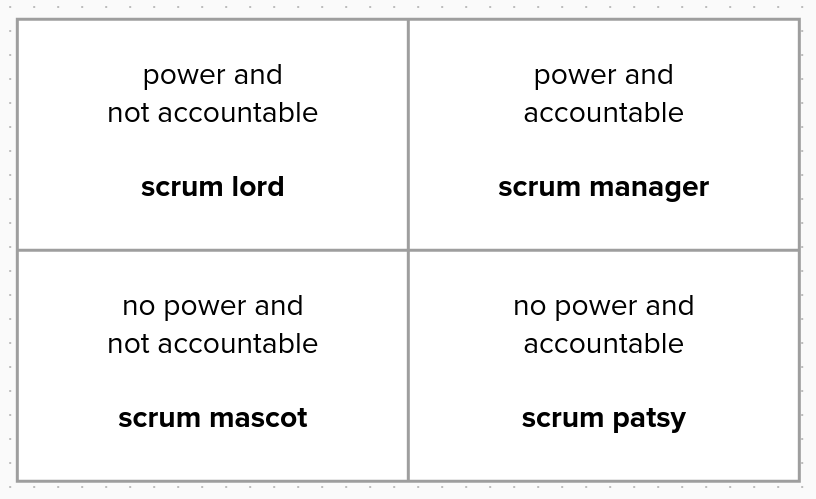Scrum master or scrum mascot?
During our latest monthly call, Maaret Pyhäjärvi and I spent some of our time discussing agency, accountability and scrum masters. At one point I said something along the lines of:
Scrum masters often end up as scrum mascots.
Maaret said I should write a blog post about scrum mascots1, so here we are.
According to the 2020 Scrum Guide a Scrum Master2 is accountable for two things:
- “establishing Scrum as defined in the Scrum Guide”.
- “the Scrum Team’s effectiveness”.
Accountability implies (or rather: should imply) corresponding authority. You’re being held accountable for certain outcomes *and* you have sufficient power to influence those outcomes. That’s a scrum master. A scrum mascot is a very different beast: they have neither power nor accountability. And yet that seems to be what a lot of organizations (and scrum masters?) want.
Scrum masters have no power
Scrum masters are managers without power. They are managers because they’re expected to establish scrum and ensure the team’s effectiveness. Yet, they don’t have the power associated with a management role. To decide what needs to be done, there’s someone with the title of “product manager”. To manage the team and the work, there’s someone with the title of “engineering manager”.3 Of course, not all organizations have product managers and/or engineering managers. However, even if you don’t, I’m quite sure that the power of these roles has not ended up with your scrum masters.
This doesn’t leave much power for the scrum master. They’re left with the power over ceremonies: scrum events and workshops. While it is possible to exert some power that way, it does leave the scrum master on the sidelines. Not involved in the work itself and not included in decisions about the work.
Scrum masters are not accountable
Scrum masters are supposed to establish Scrum and increase the team’s effectiveness. They do the former “by helping everyone understand Scrum theory and practice” and the latter “by enabling the Scrum Team to improve its practices”.4 So basically: make the team do Scrum and then make them do it better.
I think it’s very rare for scrum masters to be held accountable in this way. Because very few people know whats in the Scrum Guide beyond the scrum events. That’s also the reason that as a manager, you hire a scrum master as your scrum expert.
And even if a manager would have the knowledge and insight to hold their scrum master accountable, I’m not sure they’d want to. Because scrum is more radical than you’re ready for. Do you want your Scrum Teams to be “self-managing, meaning they internally decide who does what, when, and how”? Do you want your Scrum Master to be “Removing barriers between stakeholders and Scrum Teams”? Do you want Scrum to make “visible the relative efficacy of current management, environment, and work techniques”? Or to take a more concrete example, how often do your sprint reviews actually include that “attendees [the Scrum Team and stakeholders] collaborate on what to do next.”?5
Scrum master or scrum mascot?
With scrum masters not having any power beyond ceremonies and not being held accountable beyond a de-radicalized, bland version of Scrum, they aren’t scrum masters, they’re scrum mascots. Their value isn’t in what they do, it’s in their presence. They don’t need to bring change, they just need to be there. And while arguably even that brings some value, it’s in the margins, at the sidelines. And I can’t help but think that there has to be a better way.
The scrum master quadrants
Since this whole power/accountability-angle lends itself well to a quadrant model, I couldn’t resist:

-
I can’t imagine being the first person to utter the phrase “scrum mascot”, but the only thing I could find is this article about agile mascots by David McThomas: The Agile Mascot: Propaganda or Embodyment (May 2020). ↩
-
For a longer description of what a scrum master is, including a comparison between the 2017 and 2020 Scrum Guides, see my previous post: What is a scrum master? ↩
-
Which isn’t a very Scrum-like way to organize yourself. On the other hand, the 2020 Scrum Guide has 8 occurrences of “manag*”: 1x “current management”, 2x “Product Backlog management”, 2x “self-managing”, 2x “self-management”, and “They [the Scrum Team] are structured and empowered by the organization to manage their own work.” So it’s also valid to say that Scrum does not have an opinion on how to organize yourself beyond the Scrum Team. ↩
-
See the Scrum Master section of the 2020 Scrum Guide. ↩
-
All quotes from the 2020 Scrum Guide. ↩